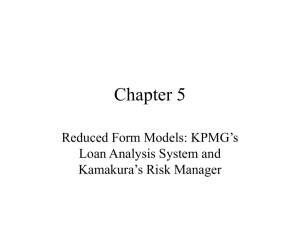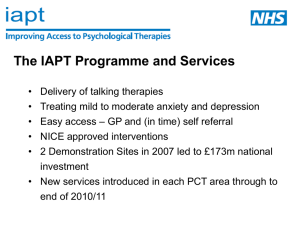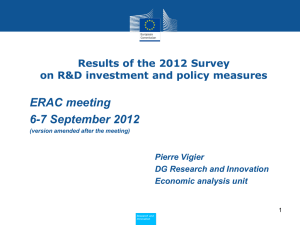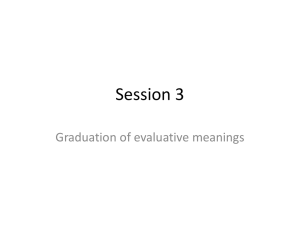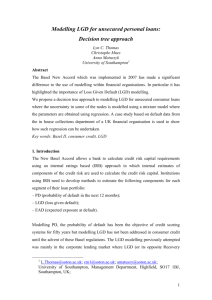Lecture 4 – Intensity-Based Models
advertisement
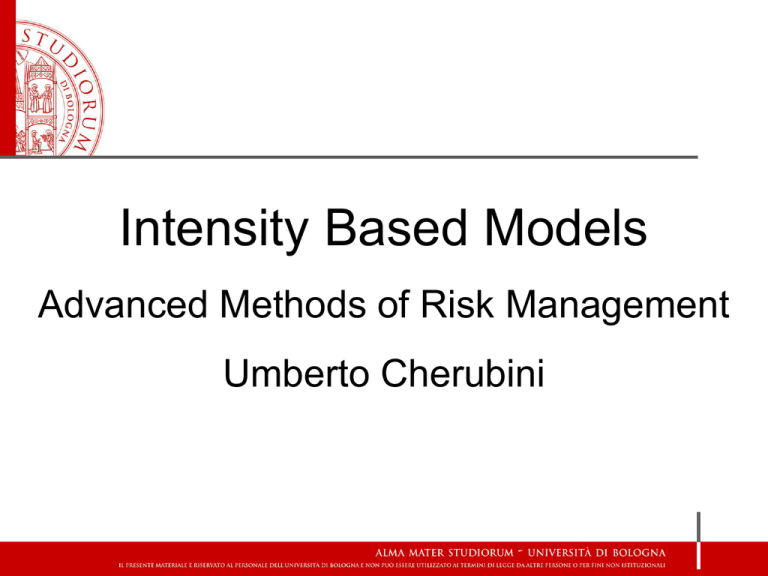
Intensity Based Models Advanced Methods of Risk Management Umberto Cherubini Learning Objectives • In this lecture you will learn 1. Extract default intensity from market data 2. Model the dynamics of the intensity of default and the credit spread 3. Calibrate the recovery rate from the CDS and the bond markets 4. Extend the model to portfolios Reduced form models • In the reduced form models, default probability and recovery rate (LGD) are modelled based on statistical assumptions instead of an economic model of the firm. • The modelling techniques that are used are very close to those applied in insurance mathematics, specifying the frequency of occurrence of the event (default probability) and the severity of loss in case the event takes place (loss given default) • These models use then the concept of intensity and for this reason are also called intensity based Credit spread and survival analysis • Denote, in a structural model, Q the probability of survival of the obligor after the maturity of the obligation, (the default probability is then DP = 1 – Q) and LGD the loss given default figure. Then, the credit spread is given by Credit Spread = – ln[1 – (1 – Q )LGD]/(T – t) • Assume now the most extreme case in which all the exposure is lost (LGD = 1). We have Credit Spread = – ln[Q]/(T – t) • Models from survival analysis (actuarial science) can help design the credit spread. The simplest model • Assume the default event to be drawn from a Poisson distribution (remember that it describes the probability of a countable set of events in a period of time). • The Poisson distribution is characterized by a single parameter, called intensity. The probability that no event takes place before time T (in our case meaning survival probability beyond that)is given by the formula Prob( > T) = exp (– (T - t)) Constant intensity model • Applying the survival probability function Q = Prob( > T) = exp (– (T - t)) to the credit spread formula (again under the assumption LGD = 1) Credit Spread = – ln[Q]/(T – t) we get Credit Spread = Intensity vs structural • Intensity denotes the probability of an event in an infinitesimal interval of time. The expected time before occurrence of the event is 1/. • Differently from structural models, the default event comes as a “surprise”. Technically, it is said that default is an inaccessible time. • The intensity corresponds to the concept of instantaneous forward rate in interest rate models. Cox models • If the intensity parameter is not fixed, but changes stochastically with time, the model is called Cox model (or double stochastic models) • For every maturity we can consider an average intensity (t,T) and the credit spread curve will be Credit Spread(t,T) = (t,T) • Notice that the relationship between , that is the instantaneous intensity, and the average intensity is the same as that between instantaneous spot rate and yield to maturity in term structure models Affine intensity models • Assume the dynamics of default intensity is described by a diffusive process like d (t) = k( – (t))dt + dz(t) where setting = 0, 0.5 deliver standard affine term structure models for the credit spread Debt(t,T) = v(t,T)exp(A(T-t) - B(T -t) (t)) with A and B the affine functions in Vasicek ( = 0) or Cox Ingersoll Ross ( = 0.5) models Positive recovery rate • If we assume positive recovery rate (and so LGD < 1) and independence between interest rate in default intensity we can easily extend the analysis. Denote the recovery rate and compute Debt(t,T; )=v(t,T)[Prob( > T)+ Prob( T)] Debt(t,T; )= v(t,T) +(1-) Prob( >T)v(t,T) Debt(t,T; 0)= Prob( >T)v(t,T), from which... Debt(t,T; )= v(t,T) +(1-) D(t,T; 0) • The price is obtained as a portfolio of the risk free asset and a defaultable exposure with recovery rate zero. Default probabilities • The spread of a BBB 10 exposure over the risk-free yield curve is 45 basis points. • Assuming zero recovery rate we get Prob( >T) = exp (– .0045 10) = 0.955997 and the probability of default is 1 - 0.955997 = 4.4003% • Assuming a 50% recovery rate we have Prob( >T) = [exp (– .0045 10) - ]/(1- ) = 0.911995 and default probability is 1 - 0.911995 = 8.8005% Recovery rate • The other point involved in modelling the expected loss refers to the recovery rate. • This topic is particularly involved, and the research on the subject is not very developed. • In particular, the point is how to recover – the value of the recovery rate – the dependence of recovery rate and default – whether the recovery rate is computed with respect to face value or market value, or other Recovery rate and default • In case the recovery rate is independent of the default probability expected loss can be computed using whatever distribution defined on the support between 0 and 1 • Typical example is the beta distribution that is very often used to study the recovery from samples of defaults. • Altman,Resti and Sironi find that the number of defaults and the amount of recovery are negatively correlated across business cycles Recovery of what? 1. Recovery of face value: it is the legal concept of recovery. Once in default, payments of interest is stopped and a fraction of principal is allocated to creditors 2. Recovery of treasury: it refers to a fraction of a risk free bond (Treasury!!) with the same financial structure of the defaultable bond 3. Recovery of market value: it refers to the market value of the bond prior to default Recovery of face value • It is based on the idea of legal default. It is useful for corporate bonds. • Moody’s compute the recovery rate as the ratio of the value of the bond on the secondary market one month after default and the face value. • Technically, default should be considered at every time, assuming that the bond is substituted with a percentage of par. • In practice, it can be approximated assuming payment of the recovery at maturity of the bond, as in the previous example. Recovery of treasury • It is based on the assumption that in case of default there is rescheduling. • It is typical of sovereign risk applications in which case there is no formal bankruptcy procedure leading to recovery of fraction of par • Typical example is the concept of “haircut” that is currently used in the current discussion on the sovereign debt crisis in the Euro area. Recovery of market value • It is considered as an approximation that makes the model easier to handle. • In fact, it turns out that intensity can be modified by allowing for the intensity to be adjusted by LGD. Namely, in the simple constant intensity model, with intensity , one could adjust the intensity to * = LGD. • In a discrete time setting, the one-period interest rate (r + LGD)/(1 – LGD) The case of OPS Argentina • In 2005 Argentina offered a swap program of bonds defaulted in 2001 for two structures of bonds • Discount bonds: maturity 12/2033, coupons 7.82% (capitalized until 12/2013). Exchange ratio 33.70% • Par bonds: maturity 09/2038, lower coupons step up (2.26%, 3.38%, 4.74%) amortizing schedule 20 equal payments starting in the last 10 years. Exchange ratio: 100% 28/03/2010 28/01/2010 28/11/2009 28/09/2009 28/07/2009 28/05/2009 28/03/2009 28/01/2009 28/11/2008 28/09/2008 28/07/2008 28/05/2008 28/03/2008 28/01/2008 28/11/2007 28/09/2007 28/07/2007 28/05/2007 28/03/2007 28/01/2007 28/11/2006 28/09/2006 28/07/2006 28/05/2006 28/03/2006 28/01/2006 28/11/2005 The prices of the OPS bonds 120 100 80 60 Discount Par 40 20 0 Argentina CDS CDS n Q(n) Q(n 1) 1 LGD CDS n CDS n 1 n 1 v0, i Qi 1 v0, n LGD i 1 Maturity 1 2 3 4 5 6 7 8 9 10 Swap Rate Discount 1,12 0,989 1,40 0,973 1,72 0,950 2,03 0,922 2,31 0,891 2,56 0,857 2,76 0,823 2,93 0,789 3,07 0,756 3,189 0,723 CDS 714,41 823,16 836,18 841,90 845,32 829,51 818,17 813,84 810,43 807,79 v(0,i)Q(i-1) 0,989 0,8567589 0,6892958 0,5705105 0,470926 0,3874916 0,3306688 0,2815426 0,236256 0,1981686 Q(n) 0,881 0,726 0,619 0,529 0,452 0,402 0,357 0,313 0,274 0,24 DP(n) 11,91% 17,62% 14,73% 14,55% 14,52% 11,13% 11,18% 12,39% 12,35% 12,35% CDP(n) Intensity 11,907% 12,68% 27,432% 19,39% 38,124% 15,94% 47,128% 15,72% 54,806% 15,69% 59,836% 11,80% 64,326% 11,86% 68,747% 13,23% 72,606% 13,18% 75,990% 13,19% Recovery: PAR 0,1 0,09 0,08 0,07 0,06 Face Treasury 0,05 0,04 0,03 0,02 0,01 47 45 43 41 39 37 35 33 31 29 27 25 23 21 19 17 15 13 11 9 7 5 3 1 0 Recovery: DISCOUNT 0,07 0,06 0,05 0,04 Face Treasury 0,03 0,02 0,01 57 55 53 51 49 47 45 43 41 39 37 35 33 31 29 27 25 23 21 19 17 15 13 11 9 7 5 3 1 0 OPS bonds • • • • • • • • Type: Discount Market price: 63.974 Fair Value: 151.12 EL (Face): 67.46 EL (Treasury): 87.22 Value (Face): 83.66 Value (Trs): 63.91 Recovery: 21.92% • • • • • • • • Type: Par Market price: 31.25 Fair Value: 91.22 EL (Face): 64.50 EL (Treasury): 59.22 Value (Face): 26.73 Value (Trs): 32.00 Recovery: 21.92 Portfolios of exposures • Assume we have a portfolio of exposures (for simplicity with the same LGD). We can distinguish between a very large number of exposures and a limited number of them. In a retail setting we are obviously interested in the former case, even though to set up the model we can focus on the latter one (around 50-100). • We want define the probability of loss on the portfolio. We define Q(k) the probability of observing k defaults (Q(0) being survival probability of the portfolio). Expected loss is n EL LGD kQk k 1 “First-to-default” derivatives • Consider a credit derivative providing “protection” the first time that an element in the basket of obligations defaults. Assume the protection is extended up to time T. • The value of the derivative is FTD = LGD v(t,T)(1 – Q(0)) • Q(0) is the survival probability of all the names in the basket: Q(0) Q(1 > T, 2 > T…) “First-x-to-default” derivatives • As an extension, consider a derivative providing protection on the first x defaults of the obligations in the basket. • The value of the derivative will be x n k 1 k x 1 FTDx LGD kQk xLGD Qk Probability Q(x) specification • Evaluating basket credit derivatives and the credit risk of a portfolio requires to specify the joint distribution of defaults Q(x) • This distribution depends on two elements – Default probability of each obligation in the basket. – The correlation (dependence) structure of defaults of the obligations in the portfolio. Models for Q(x) • Hypotheses about individual exposures are – Homogeneous pool of exposures (same default probability) – Heterogeneous pool of exposures (different default probabilities) • Hypotheses about dependence structure are – – – – Indipendent defaults Multivariate reduced form models (Marshall Olkin) Copula functions Factor copulas (conditionally indipendent defaults) Indipendent defaults • If we assume the defaults to be independent the most obvious choices for the joint probability are – Binomial distribution – Poisson distribution n x n x Qx q 1 q x exp i T t i T t i 1 i 1 Q x x! n n x Portfolio intensity • Poisson model is particularly useful because it allows immediate extension of reduced form models to the multivariate setting. • The indipendence hypothesis implies that Q(0) = Q(1 > T, 2 > T…) = Q(1 > T) Q(2 > T)… and, in intensity based models Q(1 > T) Q( 2 > T)…= exp[– (1 + 2 +…)(T – t)] • We then obtain a porfolio intensity as the sum of individual intensities = 1 + 2 +… The value of a first-to-default • Remember that the value of the a first-todefault swap is given by FTD = LGD v(t,T)(1 – Q(0)) • In the independent default case we get then LGDv(t,T)(1 – exp[– (T – t)]) = LGDv(t,T)(1 – exp[– (1 + 2 +…)(T – t)]) • The problem is to extend this model to the case in which defaults are dependent. Marshall Olkin distribution • Marshall Olkin distribution is the natural extension of Poisson distribution to the multivariate case. • Assume a case with two exposures. According to Marshall Olkin distribution we have Q(1 > T, 2 > T) = exp[– (1 + 2 + 12)(T – t)] where 12 is the intensity of an event “killing” both the obligations. • The correlation between the survival times is 12 = 12 /(1 + 2 + 12) Portfolio intensity • The idea behind Marshall Olkin distribution is that several shocks affect subset of the obligations in the portfolio. • The problem is that one may conceive a very high number of such shock, making calibration of the model unfeasible. • Generally the specification is proposed is with a unique common factor, and the intensity is n i 123....n i 1 Intensity risk and contagion • In Marshall Olkin distribution each exposure in the portfolio is subject to idiosyncratic shocks and shocks that are common to other exposures. • The shock that triggers default of all exposures is the ideal representation of a systemic event. • Notice that since in the Marshall-Olkin model all events (idiosyncratic and common) are independent, the models does not allow for contagion • In a possible extension, contagion can be introduced with dependence between idiosyncratic and common shocks,

